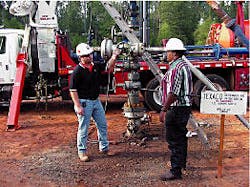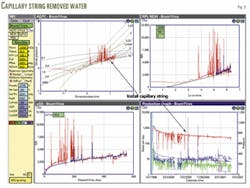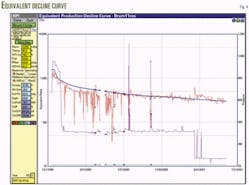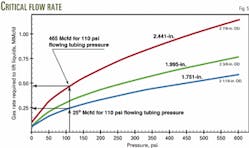A water management strategy of proactively reducing liquid loading has increased both production rates and gas recovery from multilayered, tight Cotton Valley sands.
This water management strategy is central to an infill-drilling program that employs aggressive approaches for water removal.
In producing tight gas sands, it is important to delay the onset of liquid loading so that wells need to be designed to enhance liquid removal. It also is important for one to recognize as early as possible when liquid holdup occurs in a well and then to respond quickly with counter measures.
The benefit from an aggressive liquid management program is not only the removal of the hydrostatic head but also the removal of fluids from the fracture system. Liquid loading in gas wells impedes production rates and reserve recovery. Fracture dehydration encourages stratification of gas and liquids within the fracture.
Noisy data, including painted charts and a nonsympathic rate-vs.-flowing pressure relationship, can detect liquid loading. Also, the Agarwal Gringarten type curve (AGTC) can detect early fracture fillup.
Operators have used several methods for deliquifying wells with some success. Soap injection capillary strings have made a significant difference in sustaining a productive well. The shotgun dual completion methodology has allowed successful liquid unloading in the short-term but has not sustained liquid removal long-term.
Conventional casing and small tubing appears to work best, but liquid loading should be addressed early in the life of the well.
Many companies go to great lengths to design and pump expensive fracture treatments.
That effort can be partially negated in fields like Bethany East, if thoughtful production management practices are not employed (Fig. 1).
The use of the reciprocal productivity index proved beneficial for managing the Bethany East producing operations. Liquid management improvements readily justify data acquisition costs.
It is important to have an aggressive fluid management program to maximize cash flow from a well.
Bethany East
The East Texas Bethany East field, about 20 miles east of the Carthage (Cotton Valley) field, extends east to the Louisiana state line. A typical well has 220 ft of net producing sands between 8,100 and 9,150 ft.
The upper Cotton Valley consists of two primary producing members. The middle Cotton Valley has up to four primary producing members, and the lower Cotton Valley has two primary producing members. Interspersed water-bearing layers lie between the gas-producing members of the middle Cotton Valley.
Operators typically complete a new infill well in the middle and lower Cotton Valley sands by hydraulically fracturing the intervals with 100,000-125,000 gal of fluid and 200,000-250,000 lb of 20/40 Ottawa sand. Frac treatments in the upper Cotton Valley, when completed, use 70-quality nitrogen and about 175,000 lb of sand. Texaco primarily has used zirconate crosslinked fluids to frac the middle and lower Cotton Valley sands.
The upper Cotton Valley has greater permeability but much lower reservoir pressure because of drainage from offset wells. Consequently, operators should not complete this zone in infill wells because close well spacing is not required to drain this section.
An important aspect of the program is the need for accurate three-phase testing on a daily basis for all completions. These rate data, along with daily pressures, enable the primary monitoring software (RPI) to determine optimum producing rates.
Prior to initiation the 1999 infill-drilling program, Texaco noted that production logging indicated that water accumulating in the wellbores impeded gas recovery. Further investigation revealed that the uppermost member of the upper Cotton Valley sands and, to a lesser extent, the top member of the middle Cotton Valley, provided much of the prior production.
Pressure data acquired in a new well showed that pressure of the top member of the upper Cotton Valley was as low as 2,500 psi whereas the bottom members still had 4,400 psi pressure.
Production surveys found water standing in most wellbores at a depth of about 8,500 ft or at the base of the top member of the middle Cotton Valley. Reports indicated that velocity strings were unsuccessful long-term in unloading water to the bottom perforation because they would quickly erode and part near the top perforation.
RPI
The reciprocal productivity index method (RPI)1 is a graphical well performance analysis tool authored by James Crafton. The method, developed around the premise of an extended drawdown test, allows production data analysis (hourly, daily, monthly, etc.) to determine permeability-thickness (kh), effective fracture half-length (skin), and drainage area.
Crafton derived that the Pi-Pwf(t)/q(t), or RPI, relationship can be used to normalize noisy production data. This method allows for the use of traditional pressure transient analysis such as the Miller Dyes Hutchinson analysis. In the relationship Pi is reservoir static pressure, Pwf is bottomhole flowing pressure, q is flow rate, and t is time.
As with any pressure transient analysis, the model is a uniform thickness, porosity, and permeability model. Pattern recognition combined with operational knowledge allows the tool to be used in several applications from reservoir evaluation to completion optimization. The method allows for a relatively quick understanding of reservoir properties.
Four to five graphs present time regimes, and early, middle, and late time behavior. The Miller Dyes Hutchinson Analysis, log time vs. RPI, is for determining kh (slope) and Xf (intercept). A pseudosteady state plot, Cartesian time vs. RPI is for determining drainage area. A log-log Agarwal Gringarten type curve can confirm model matches and determine time regimes.
Other plots include a square root of time plot for identifying linear flow systems and a log production-vs.-time plot that lets the user understand the model in a more familiar setting. All the plots are used in concert to determine a more unique solution.
The graphical portion of the analysis allows the user to examine features such as formation linear flow behavior, liquid loading in the wellbore and the fracture, reservoir pressure, multilayered effects, etc.
Liquid management
RPI software confirmed the production survey work. In the Cotton Valley trend, the software noted multilayered effects in several wells, including the development of liquid loading that contributed to small drainage areas and short effective fracture half-lengths, in spite of large fracture treatments. Water in a wellbore virtually guarantees that the fractures have not been dehydrated efficiently.
Initial RPI analyses prompted operators to use capillary strings to help foam water out of the wellbore. Because area operators had experienced premature failures of velocity strings, they typically set tubing strings above the top perforation.
Amoco Production Co.'s extensive experience has shown, and this project has verified, that capillary strings do a fairly good job of unloading liquids from tubing strings.2
In other cases, compression has reduced the critical flow rate and increased liquid unloading. For example, a compressor installed in April 2000 increased water production by 30 b/d and gas production by 100 Mcfd (Fig. 2). It also eliminated most of the erratic production behavior.
The Agarwal Gringarten-type curve plot (AGTC in Fig. 2) indicates that the well has moved back toward an infinite acting flow behavior but it still is not fully infinite acting. Damage still exists from the liquid filling the hydraulic fracture.
Besides installation of capillary soap strings, other completion philosophies determined from the RPI analysis led to improved water recovery.
The shotgun dual was the original completion methodology. The design consisted of running and cementing two strings of 27/8-in. tubing side-by-side rather than the conventional approach of stringing tubing inside casing. Shotgun duals had been used in the area in the past, but their purpose had been to provide the flexibility to complete a shallower reservoir up a separate string, such as the Travis Peak, at the same time as the Cotton Valley.
Improved water management was the new purpose for the shotgun dual. Texaco expected the two completion strings to more readily isolate and restrict excessive water within only the Cotton Valley.
Production shut-in and water holdup are known, in many cases, to be detriments to efficient production. To minimize water hold-up, one should commence flow back as soon as possible after a fracture treatment. Ideally, the well should never be shut-in.
Analysis has shown that fluid will migrate into the fracture during a shut-in and be more difficult to remove, particularly in an older well. Shotgun dual completions offered the potential to reduce the duration and frequency of shutting in a well. Further, they provide an option to complete in shallower reservoirs (some of which are notoriously unpredictable channel sands) and to test Cotton Valley members in different combinations and even to defer some completions.
RPI analysis has shown that maintaining the tubulars and the hydraulic fracture as water free as possible is important for maximizing production rate and recovery. This tool has permitted loading problems to be seen in the analysis and also to observe the cleanup.
Figs. 3 and 4 depict a well with an installed capillary string. The production noise was eliminated and the well returned to near-infinite acting behavior.
The analysis used a 40-acre drainage area to match the production data. Many wells with loading problems will drain only 10-20 acres (mean is 19.2 acres). This problem, in part, has driven the current drilling program.
Shotgun dual results
Shotgun dual completions did not work as well as hoped because the primary cement jobs on the two tubing strings did not provide sufficient isolation, causing production problems later. The two side-by-side tubing strings also required oriented, 0° phased perforating.
Increased tortuosity occurred when the perforations were oriented away from the least principle stress in the reservoir. This orientation can cause multiple fractures, and corresponding reduced stimulation effectiveness.
The two 27/8-in. tubing strings allowed 30 bbl/min stimulation rates, but proved too large for efficient production. The critical producing rate at a typical 200-psi flowing tubing pressure is about 800 Mcfd. When the wells declined below that rate after a few months, water lifting problems occurred as before even though not readily apparent without the RPI analysis.
Fig. 3 illustrates these problems. This completion produced from the Roseberry that is the second deepest Cotton Valley member. The well declined rapidly shortly after being completed, and the production data became very noisy, indicating water loading.
The AGTC plot appeared to indicate a depletion stem. The operator installed a capillary string after 250 days to inject soap. This improved liquids removal and dampened the erratic production behavior.
The type curve returned to the infinite acting line with an indicated current drainage area of 40 acres. This was good news, but the downside is that maintenance and expense of soap injection and the capillary string will have to continue for the life of the well.
Optimized completion
For the last several months, the drilling program included production casing, initially with a single 23/8-in. tubing string but more recently with two 21/16-in. tubing strings after a fracture treatment through casing. The program includes the second tubing string if a zone uphole of the Cotton Valley is to be completed.
This arrangement has several advantages over the shotgun dual approach, as follows:
- Provides a more effective cement bond with the casing.
- Allows stimulation treatments down the casing with 60° phased perforations to minimize tortuosity effects.
- Allows isolation of highly water productive zones.
- Allows lifting fluids through two tubing strings
Critical flow rate curves (Fig. 5) show that fluids in 2 1/16-in. tubing can be lifted at flow rates 100-300 Mcfd less than in 23/8-in. tubing.
For the fracture treatment, initial conclusions suggested that observed fracture half-lengths were a magnitude different than design, 150-200 ft vs. 500-800 ft. The presence of liquids in the fracture system may have caused the shorter observed fracture half-lengths.
The model assumes that the fluids in the system are in a gaseous state. The difference in observed fracture lengths can be attributed to the square root of the difference in the viscosity relationship between gas, about 0.02 cp, and water, about 1 cp.3 A seven-fold increase in fracture half-length (Xf) describes the actual stimulation, if the fracture is liquid loaded.
Some sands producing free water have a wellbore that is not capable of dewatering the fracture fast enough. On the AGTC plot, from production data, the data cutting across the depletion stem while remaining parallel to the type curve lines indicate a loss of fracture conductivity (Fcd), which might indicate water loading up the fracture system.
Unknown is the time that a fracture maintains its effective length. It is one thing to create and prop a hydraulic fracture, and it is entirely another to retain that fracture's initial length and conductivity throughout the life of the well.4
The combination of low kh reservoirs, production shut-ins, and natural decline causes more and more fluid to be retained in the fracture, thus reducing fracture conductivity and effective fracture length. The more pronounced effect of this is toward the fracture tip.
This nonideal behavior results in additional decline that the RPI software can observe. For example, a new well may be having problems when the RPI data shows that the well has gone from infinite acting to a decline mode after achieving a drainage radius of only 1-10 acres. Of course, the well still is in an infinite acting mode. The problem is the loading that is occurring.5
Changing the well's production rate can generate new production transients, but one can easily and independently analyze these new transients. A reduction with time in calculated fracture length may indicate water holdup in the fracture. For this reason, Texaco has scaled back the stimulation fluid volumes.
References
- Crafton, J.W., "The Reciprocal Productivity Index Method, A Graphical Well Performance Simulator," 43rd Southwestern Petroleum Short Course, Lubbock, Tex., Apr. 16, 1996.
- Awadzi, J., et al., "Downhole Capillary Soap Injection Improves Production," Paper No. SPE 52153 Mid-Continent Operations Symposium, Oklahoma City, March 1999.
- Crafton, J.W., Reciprocal Productivity Index Short Course, Texaco Denver Office, August 2000.
- "Reservoir, Completion and Stimulation Optimization Study," unpublished engineering study for Cotton Valley formation, East Bethany field, Panola County, Tex., Integrated Petroleum Technologies Inc., September 2000.
- Crafton, J.W., "Well Evaluation Using Early Time Post-Stimulation Flowback Data," Paper No. SPE 49223 SPE Annual Technical Conference & Exhibition, New Orleans, September 1998.
The authors
Paul Sauer is a senior engineer for Texaco Exploration and Production Inc. in Denver. He works with the Arkoma-Hugoton development team and serves as a resource and mentor for engineers. Sauer received a BS in petroleum engineering from Texas Tech. He is a registered professional engineer in Oklahoma and an SPE member.
Lon Stuebinger has held numerous management and engineering positions with Texaco Exploration and Production Inc. He has received company and industry awards pertaining to his patents and industry articles in the area of produced water management. Stuebinger is a registered professional engineer with a BS in petroleum engineering from the Colorado School of Mines.
Mark H. Yamasaki is a senior technical advisor for Performance Sciences Inc., Denver. Prior to joining PSI, Yamasaki worked for Amoco Produc tion Co. as an operations and completions engineer in the San Juan basin. Yamasaki has a BS in petroleum engineering from the Colorado School of Mines. He is an SPE member.








